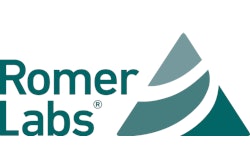The cold, wet harvest of 2009/10 brought with it, not only handling problems, but increased incidents of vomitoxins, a mycotoxin which is a naturally occurring chemicals produced by a variety of molds; and they will continue to be a thorn in the side of elevators into the future.
“It’s been an unusual year indeed,” says Paul Pfeiffer, territory managers — grain & milling, Neogen, says. “In some areas, elevators are lucky to get one out of 10 trucks with an acceptable level in some areas.”
Test kits are the first line of defense for producers and exporters to ensure regulatory compliance in order to protect human and animal health. While some may suggest that a firm can’t test every load and recommend testing fewer loads to form a composite of the risk level, in areas when mycotoxins are endemic, this strategy is frowned upon.
Once a mycotoxin contaminated grain enters the bin, it’s hard to get back out, so it’s in the best interest of small- to medium-sized elevators to increase testing since an incident may be harder for them to manage.
While most elevators test and test often, others draw composites of there is a low-level of grain. Why wouldn’t they? Honestly, some just don’t want to know.
“Testing grain should be viewed more as more of an insurance policy,” says Stephen Nenonen, sales manager, Romer Labs. “Some elevators are required to test depending on who they sell to, others are not. The ones that aren’t required do it anyway because they want to ensure their grain quality.”
The last thing any elevator wants is a recall, Nenoner says. Whether you’re shipping abroad or marketing your grain domestically, it’s a “better safe than sorry” scenario.
Wes Shadow, business development manager with Perten Instruments, agrees: “Food Safety will continue to be a huge issue. It’s in the best interest of [elevators] to be able to verify the quality of their grain.”
The USDA, FDA and other international regulatory standards impose specific guidelines for acceptable levels for various mycotoxins, such as aflatoxins, fumonisin, deoxynivalenol, ochratoxin, etc,. For example, the USDA Grain Inspection Packers and Stockyard Administration’s (GIPSA) acceptable limit for aflatoxin is 20 parts/billion. (For additional sampling information, visit www.gipsa.usda.gov/GIPSA.)
While different environmental conditions breed different mycotoxins, there are occasions where multiple types of toxins may be found. Mycotoxin test kit suppliers have focused their attention on multiple toxin testing to meet this demands.
“Sometimes it’s less economical for the user to do multiple tests so these one-stop test kits provide the quick and easy solution,” Pfeiffer explains.
In addition to detection, rapid process speeds are essentials to efficiency at the scale.
Testing speed offers segregation benefits
Quick test times are the key to keeping trucks flowing smoothly past the scale and the probe during peak times. While in past some may have been hesitant to increase the frequency of evaluation, for fear of creating at bottleneck at the probe, today most test kits require 5 to 10 minutes to process.
“Our tests are quick enough that results are submitted before they get off the scale, allowing the operator to direct the truck to the appropriate pit,” Nenonen says.
Since mycotoxins are not homogenous in their distribution in, the best strategy is to test every load at intake. The benefit — regardless of whether or not you have been altered to a rise of mycotoxin in your region — is that it will allow you to manage your quality through segregation. “The accurate [segregation] testing allows protections from loss — both from losing on the grade of the grain and from losing customers,” explains Patricia Jackson, Vicam’s market development manager.
Such segregation and mycotoxin testing is exceptionally useful for ethanol plants.
In the interest of DDGS
In the past DDGS may have been an afterthought, but today with increasing use of DDGS in feed, mycotoxin testing, grain quality and level tracking is especially important. Since mycotoxins are chemical and not biological properties, they are not “killed” or removed in the ethanol distillation process — but instead are concentrated three-fold in the process. As a result, ethanol plants have more aggressively been testing inbound corn.
As environmental conditions compromise the integrity of grain, only time will tell which mycotoxins, may present themselves this year. Test often to protect your assets and the quality of your grain.
For more information on the test kits available, check out the product spotlight on page 49.


















